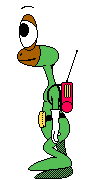|
Different
Perspectives about World War II
A Web Quest for 8th-12th Grade
(Art, World History, Social Studies, English, and Literature)
Designed by
Wendi Callaway, M. S.
Artonthemove_2000@yahoo.com



Introduction | Task
| Process | Evaluation
| Conclusion | Credits
| Teacher
Page
Introduction
In a group of three to five people,
you will each choose one of the following roles, through whose
perspective you will answer all of the questions in this quest for
information about the past as well as participate in the physical
activities assigned.
Each person in your group needs to
choose a different character to portray.
Your choices are:
1.
A German soldier serving under Adolf Hitler in the Third Reich
during World War II.
2.
An elderly Jewish person in Germany during World War II.
3.
A Japanese bomber pilot in World War II.
4.
An American soldier who has just been sent to fight on the front
line in Europe during World War II.
5.
An American civilian who has
family members fighting in the war, and who has been stranded in Europe
for several months.
The
Task
As your character, and from the
perspective of your character, you will complete the following tasks:
- You
will answer questions pertaining to your character, using the
Internet resources listed in the Resources section.
- You
will analyze your character, using the guidelines provided.
- You
will work collaboratively with your group in writing a short skit
that evolves around a given situation or set of circumstances, which
will be provided for you.
- You
will write a response, from the perspective of your character, to a
specific letter written by someone else involved with the war.
- You
will write an evaluative reflection about the other characters in
your group, and about their position/duties in regards to the war.
The
Process
- First
you'll be assigned to a team of 3-5 students.
- Each
one of you will choose one of the roles listed in the Introduction.
- Follow
the link below for your character.
This will take you to the next set of instructions.
- Once
you have completed the instructions for your character, you will be
reunited with your group members for the final group activities.
Character #1óThe German soldier
Character #2óElderly Jewish
person
Character #3óJapanese bomber
pilot
Character #4óAmerican soldier
Character #5óAmerican civilian
Evaluations
The final group activity will be
evaluated by using the following rubric.
|
|
Beginning
1
|
Developing
2
|
Accomplished
3
|
Exemplary
4
|
Score
|
|
Background
information provided on character.
|
The student has
provided very few facts about his or her character that help the
audience understand that characterís perspective in the provided
situation.
|
The student has
obviously done some research about their character, but it is hard
to distinguish the characterís perspective on the provided
situation.
|
It is obvious
that the student has done enough research about his or her
character to give the audience some sense of the characterís
perspective in the situation.
|
The student has
completed detailed research about his or her character, because it
is evident that the characterís perspective in the situation is
clear and well thought out.
|
|
|
Response
to written letter
|
The studentís
response to the provided letter is poorly written and lacks any
emotion.
|
The studentís
response to the letter is either too short or poorly written and
not emotional enough.
|
The studentís
written response to the letter is adequate in length, is well
written, but lacks in emotional content
|
The studentís
written response to the letter is a good length, well written, and
full of emotion.
|
|
|
Contribution
to the creation of the collaborative group project
|
Through
observation, it is evident that the student has contributed close
to nothing towards the completed skit. None of the objectives for
the skit have been met
|
The student has
contributed some insight to the dialogue or actions in the writing
of the skit. Very few of the objectives for the skit have been
met.
|
The studentís
ideas for the skit have been well thought out, and their
contribution enhances the performance. Most of the
objectives have been met
|
The student has
shown good leadership skills in organizing the vents of the skit
and in the disbursement of duties to all group members. All
of the objectives have been met.
|
|
|
Performance
in collaborative group project
|
The studentís
performance is poor and lacking in effort or believability.
|
The studentís
performance is okay although it lacks in enthusiasm or effort.
|
The student shows
sufficient effort and enthusiasm during the performance.
|
The studentís
performance is remarkable, full of enthusiasm and obviously well
thought out.
|
|
|
Evaluative
reflection about other characters
|
It is obvious
that the student has not put any effort into listening to or
thinking about the other characters.
|
The student is
able to identify some aspects about one or two of the other
characters.
|
The studentís
evaluation of the other characters is sufficient, yet not very in
depth.
|
The studentís
evaluation of the other characters is well written and very in
depth.
|
|
Conclusion
By completing the activities in
this Web Quest, you should have a better understanding of the various
types of people involved in World War II, and how the war affected those
peopleís lives. By
discovering the effects of the war on the people who were directly
involved with it, it should be easier to see how the war affected
everything from domestic life, to the workplace, to peopleís sense of
security and freedom and even to the ways people expressed their
feelings, especially through the arts.
Credits
& References
List here the sources of any
images, music or text that you're using. Provide links back to the
original source. Say thanks to anyone who provided resources or help.
List any books and other analog
media that you used as information sources as well.
Last
updated on August 15, 1999. Based on a template from The WebQuest Page
|


